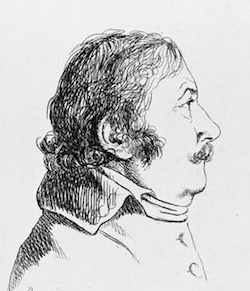General Charles François Joseph Dugua

Born: March 1, 1744
Place of Birth: Valenciennes, Nord, France
Died: October 16, 1802
Cause of Death: Illness
Place of Death: Cap-Haïtien, Saint-Domingue
Arc de Triomphe: DUGUA on the south pillar
Pronunciation:
Enlisting in 1760 in the infantry at the young age of sixteen, Charles François Joseph Dugua was commissioned a sous-lieutenant only three years later. In 1765 he was promoted to lieutenant, but twelve years later in 1777 he resigned from the military. After the onset of the French Revolution Dugua returned to the military, becoming a lieutenant of gendarmerie in Haute-Garonne in June of 1791. At the end of 1792 he was promoted to colonel of the 2nd Legion of Gendarmerie organized at Versailles, and then in 1793 he was sent to the Army of the Eastern Pyrenees. Dugua served at the combat of Truillas in July and then in August he was promoted to général de brigade by the representatives of the people with the army. Next he served as chief of staff of the force besieging Toulon , and during that siege he was promoted to général de division by the representatives of the people.
After the successful conclusion of the siege of Toulon, Dugua returned to the Army of the Eastern Pyrenees. In January of 1794 he took command of the cavalry of the right wing of the army, and then five months later in June he took command of all the cavalry of that army. Dugua fought at the Battle of Montagne Noire in November and then served on the Fluvia in June of 1795. Peace was then concluded with Spain that summer and Dugua was not included in the reorganization of the army that sent much of the army to join the Army of Italy. Instead he was sent to the Army of the Coasts of Cherbourg which later became part of the Army of the Coasts of the Ocean. In October of 1796 Dugua was sent by General Hoche to reinforce the Army of Italy with a number of reinforcements, and after arriving in Italy he took command of the cavalry reserve. In 1797 he served on the Brenta, he was wounded at Sacile, he served on the Tagliamento, and then he occupied Trieste. Dugua took command of a cavalry division that June and then in November he was appointed commander of the 14th military division at Caen.
In March of 1798 General Dugua was sent to the 8th military division at Toulon. The following month he was elected a deputy of Calvados to the Council of 500, but in May he was then employed in the Army of the Orient as inspector general of both the infantry and the cavalry. Dugua embarked for Egypt with the rest of the army, and after arriving in Egypt he temporarily took command of Kléber's division after Kléber was injured at Alexandria. Dugua went on to distinguish himself in July at the action of Rosetta and then the Battle of the Pyramids . He next fought at the action of Cairo and was then named governor of the province of Mansourah. In February of 1799 Dugua was named commander of Cairo, a position he held until March of 1800 when he set off to return to France.
Once back in France Dugua took command of the 10th military division at Toulouse and was appointed a prefect of Calvados. In October of 1801 he was appointed chief of staff of the army designated for the expedition to Saint-Domingue and so he went to Brest to embark with the fleet. Dugua and the army arrived in Saint-Domingue in February of 1802 and the next month he fought at the siege of the fort of Crête-à-Pierrot where he was grievously wounded. Dugua held abolitionist beliefs and later that year as Leclerc ordered more and more executions in a questionable and misguided attempt to stop rebellion, Dugua warned colonial units about impending massacres.1 He succumbed to yellow fever that October.
Notes
Bibliography
Related Pages:
Updated June 2024
© Nathan D. Jensen